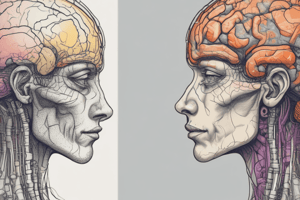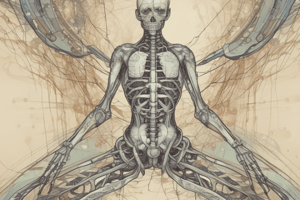Podcast
Questions and Answers
What is the primary concern when monitoring patients with a spinal cord injury?
What is the primary concern when monitoring patients with a spinal cord injury?
- Bowel function
- Neurological status
- Respiratory function (correct)
- Skin integrity
Which of the following best describes neurogenic shock?
Which of the following best describes neurogenic shock?
- A loss of autonomic nervous system function (correct)
- Severe pain and muscle spasms
- Increased heart rate and temperature
- A sudden increase in blood pressure
How does autonomic dysreflexia typically present in patients?
How does autonomic dysreflexia typically present in patients?
- Profuse sweating and bradycardia
- Anxiety and tachycardia
- Severe headache and hypertension (correct)
- Dizziness and visual disturbances
Which mechanism can lead to head injuries in adults?
Which mechanism can lead to head injuries in adults?
What Glasgow Coma Scale score indicates a need for mechanical ventilation?
What Glasgow Coma Scale score indicates a need for mechanical ventilation?
Which of the following is a manifestation of skull fractures?
Which of the following is a manifestation of skull fractures?
In spinal cord injuries, tetraplegia affects which extremities?
In spinal cord injuries, tetraplegia affects which extremities?
What is a potential complication of spinal cord injury related to bowel function?
What is a potential complication of spinal cord injury related to bowel function?
Neurogenic shock typically presents with which of the following symptoms?
Neurogenic shock typically presents with which of the following symptoms?
Which positioning issue may cause complications for spinal cord injury patients?
Which positioning issue may cause complications for spinal cord injury patients?
A blown pupil is indicative of which type of neurological condition?
A blown pupil is indicative of which type of neurological condition?
Which of the following should take priority when caring for a patient with a spinal cord injury?
Which of the following should take priority when caring for a patient with a spinal cord injury?
What test is used to determine if fluid draining from the nose is cerebrospinal fluid?
What test is used to determine if fluid draining from the nose is cerebrospinal fluid?
Which condition is a common cause of spinal cord injuries in adults?
Which condition is a common cause of spinal cord injuries in adults?
Glasgow Coma Scale scores help assess a patient's level of consciousness. Which score indicates a severe impairment?
Glasgow Coma Scale scores help assess a patient's level of consciousness. Which score indicates a severe impairment?
Flashcards
Neurogenic Shock
Neurogenic Shock
A life-threatening condition resulting from spinal cord injury, characterized by widespread vasodilation and decreased blood pressure.
Spinal Cord Transection
Spinal Cord Transection
Complete severing of the spinal cord, disrupting communication between the brain and the body below the injury.
Autonomic Dysreflexia
Autonomic Dysreflexia
A potentially life-threatening condition marked by a sudden increase in blood pressure in individuals with SCI, often triggered by noxious stimuli below the injury.
Glasgow Coma Scale
Glasgow Coma Scale
Signup and view all the flashcards
Cushing's Triad
Cushing's Triad
Signup and view all the flashcards
Rhinorrhea
Rhinorrhea
Signup and view all the flashcards
Otoorrhea
Otoorrhea
Signup and view all the flashcards
Neurogenic Shock
Neurogenic Shock
Signup and view all the flashcards
Transection
Transection
Signup and view all the flashcards
Cushing's Triad
Cushing's Triad
Signup and view all the flashcards
Glasgow Coma Scale
Glasgow Coma Scale
Signup and view all the flashcards
Spinal Cord Injury (SCI)
Spinal Cord Injury (SCI)
Signup and view all the flashcards
Tetraplegia
Tetraplegia
Signup and view all the flashcards
Paraplegia
Paraplegia
Signup and view all the flashcards
TBI
TBI
Signup and view all the flashcards
Study Notes
Spinal Cord Injury and Traumatic Brain Injury
- Clinical Manifestations of Spinal Cord Injury: Clinical manifestations vary based on the level of injury (cervical, thoracic, lumbar).
- Transection: Complete disconnection of the spinal cord.
- Neurogenic Shock: A life-threatening condition following spinal cord injury. Symptoms include hypotension, bradycardia, and warm extremities. Nursing management focuses on fluid replacement, oxygen, and vasopressors.
- Spinal Cord Injury Complications: Complications include bowel and bladder dysfunction, respiratory problems, and skin breakdown. Bowel, bladder, respiratory and skin integrity are priorities in monitoring.
Autonomic Dysreflexia
- Definition: A potentially life-threatening condition characterized by paroxysmal hypertension, bradycardia, and diaphoresis.
- Cause: Typically triggered by a stimulus below the spinal cord injury.
- Management: Rapid recognition is critical to avoid severe complications, such as seizures or stroke. Management involves addressing the stimulus causing the condition (e.g., full bladder, fecal impaction).
Head Injuries in Adults
- Common Causes: Motor vehicle accidents, falls, and direct blows to the head.
Traumatic Brain Injury (TBI)
- Clinical Manifestations: Include changes in vital signs (Cushing's triad), pupillary response, and altered mental status.
- Glasgow Coma Scale: A tool for assessing the severity of a TBI by evaluating eye opening, verbal response, and motor responses. Different scores warrant different levels of intervention. A score of 8 or less often requires mechanical ventilation. A score of 3 represents profound impairment or death.
- Nursing Assessment for TBI: Components include PERRLA, hand squeeze, visual changes, changes in level of consciousness, and vital signs.
Skull Fractures
- Manifestations: Rhinorrhea (CSF drainage from the nose), otorrhea (CSF drainage from the ear), and neurological findings.
- Important Considerations: CSF drainage requires immediate medical attention. Do not perform a lumbar puncture in spinal cord injury patients.
Studying That Suits You
Use AI to generate personalized quizzes and flashcards to suit your learning preferences.
Related Documents
Description
This quiz covers important clinical manifestations of spinal cord injury and traumatic brain injury. It explores topics such as neurogenic shock, autonomic dysreflexia, and complications related to spinal cord injuries. Assess your knowledge on the nursing management of these critical conditions.




